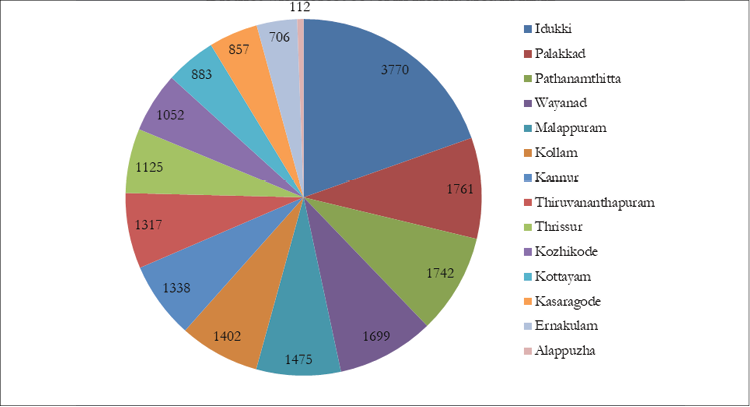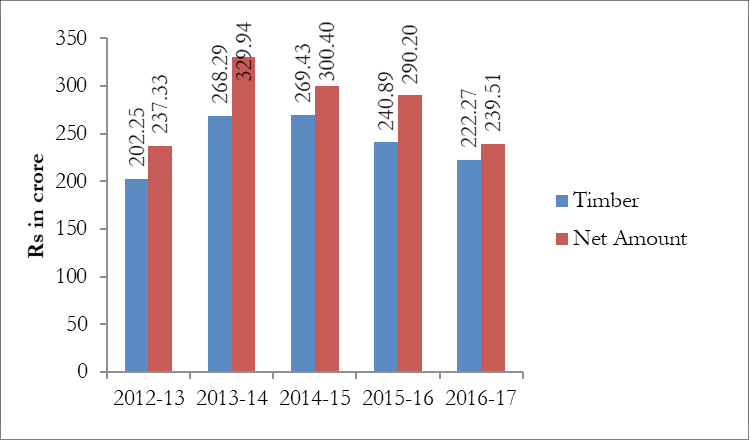Forests are fundamental for the environment, food security and improved livelihoods. Forests of the future will increase the resilience of communities by providing food, wood energy, shelter, fodder and fibre, incomes and employment to allow communities and societies to prosper and harbouring biodiversity. The concept of “forest health” is very important for its management. India is one of the few countries of the world to have a robust and scientific system of periodic forest cover assessment and of taking inventories of forests and trees outside forests. Forests in the country vary from the tropical evergreen forests in the Andaman and Nicobar Islands, the Western Ghats and the north eastern States, to dry alpine scrub high in the Himalayan region. Between the two extremes, the country has semi evergreen forests, moist deciduous forests, thorn forests, sub tropical pine forests in the lower mountain zone. As per the India State of Forests Report (2015), the total Forest and Tree cover of the country is 794,245 sq. km, which is 24.16 per cent of the total geographical area of the country. This includes 92,572 sq. km of tree cover and 701,673 sq. km of forest cover. The total forest cover comprises of 85,904 sq. km of very dense forest, 315,374 sq. km of moderate dense forest and 300,395 sq. km of open forest.
Forests and tree resources in the State can be broadly grouped into (a) those that are categorised as forests primarily under government ownership and management and (b) trees outside forests. The total geographical area of the State is 38,863 sq. km. The recorded area of reserved forests in the State is 11,309 sq. km or about 29.1 per cent of the State’s geographical area. As per the 2015 assessment made by the Forest Survey of India, the total forest cover in the State including plantations is 19,239 sq. km. On comparing 2015 FSI report with 2013, it is seen that the extent of open forests in Kerala has increased significantly whereas the area under dense and moderately dense forests have declined.
Out of the total forest cover in the State, Idukki district has the highest forest cover, with 3770 sq. km, followed by Palakkad (1,761 sq. km) and Pathanamthitta (1,742 sq. km) (Figure 2.21). District-wise details of forest cover in Kerala is given in Appendix 2.87.

In Kerala, out of the 11,309.48 sq. km of total forest area, major area is covered by tropical wet evergreen and semi evergreen (34.28 per cent) followed by Tropical moist deciduous (31.97 per cent). Classification of forest types in the State is given in Appendix 2.88.
Natural forests in Kerala are managed mainly for sustaining life support systems and for biodiversity conservation through various programmes. The major activities initiated in 2016-17 were a survey of forest boundaries, forest protection, and regeneration of denuded forests. During the period, as part of boundary demarcation, 12831 cairns and 8.41 km of kayyalas (dwarf walls) were constructed. Further, in order to regenerate denuded forests, new plantings were done in 52 ha and the existing plantations were maintained in 384.28 ha. As part of fire protection activities, 5,978.34 km of fire lines were created and 77,555 fire protection watchers were engaged.
Productivity of Plantations
In Kerala, early plantation efforts were focused on teak and this has remained the most preferred species because of its versatility and superior properties. Emerging demand for industrial raw material in recent years led to increase in establishing pulpwood yielding plantations. In order to meet the requirement, hardwood species were newly raised in 763.06 ha and 2,499.48 ha were maintained during 2016-17. Further, industrial raw materials were newly planted in 967.9 ha and 1280.78 ha were maintained during the above period. Regarding non-wood forest species, new plantations and maintenance were carried out in 124.9 ha and 544.4 ha respectively. Species wise area under forest plantation is given in Appendix 2.89.
Human-Animal Interface
Human Animal Interface occurs when the wildlife requirements overlap with those of human populations, creating costs for both communities and wild animals. With increasing population and pressure on forest areas, human wildlife interaction and the resultant conflict is also increasing. This human-animal conflict is reflected in the form of human causalities, injuries, crop damage, cattle lifting, damage to houses and property etc. Recent statistics revealed that human-animal conflict was increasing at an alarming rate in our State. During 2016-17, 7,765 incidents of human-animal conflicts were reported and 9.63 crore was paid as compensation to the victims of wild life attack.
Scheduled Tribes and other Traditional Forest Dwellers (Recognition of Forest Rights) Act, 2006
The Forests Rights Act 2006 envisages recognition of rights of forest dependent communities. The Act recognise the rights of the forest dwelling scheduled tribes and the responsibility and authority for sustainable use, conservation of biodiversity and maintenance of ecological balance of dependent communities in terms of individual and community rights. Accordingly, 25081 titles were issued for individual rights, 164 titles for community rights and 455 claims were settled for development rights. Details on individual rights are given in Appendix 2.90.
Major Forest Produce and Revenue from Forests
On analysing the production of major forest produce, it is seen that timber, sandal wood and honey occupies the top position. It is to be noted that, in 2016-17, production of timber was reduced to 31,134.51 cum from 40,909.75 cum during the previous year. Similarly, sandalwood declined to 52,102.35 kg (2016-17) from 68,644.6 kg (2015-16). Meanwhile, honey production increased from 56,176.90 kg to 60,390.05 kg during the review period. Production of major forest produce during 2015-16 and 2016-17 is shown in Appendix 2.91.
Reduction in the forest produce was reflected in the revenue from forest products. Recent statistical data revealed a declining trend in the revenue from timber over the last three years. Income from timber which was 269.43 crore in 2014-15 declined to 240.89 crore in 2015-16 and further declined to 222.27 crore in 2016-17. Reason for the declining trend was mainly due to (1) Revenue target of the department is fixed based on timber workings scheduled as per Working Plan of various divisions. But in actual practice the process is delayed mainly due to disparity between local wage rate and forest schedule of rate. (2) The e-auction of timber, which was started by the department two years back is yet to gain popularity among various sectors of bidders. In the process, the bidders coming for e-timber auctions have been less than the previous conventional auctions and in the process there is mismatch between the demand and supply.
Human-animal interface is common at the fringes of forests. In Kerala, the main animals involved are elephants, wild boars, monkeys, tigers, and snakes.
Main Causes
Magnitude of the Conflict
The conflict is in alarming stage at some pockets. The amount of money being paid as compensation is increasing year by year, thereby reflecting the intensity of the situation
145 cases of human death, 361 cases of cattle death and 6,461 cases of crop damage and property loss were reported during 2016-17.
Relief to Victims
Action Taken
Trend in revenue from timber and other forest products from 2012-13 to 2016-17 is shown in Appendix 2.92. Figure 2.22 depicts the revenue from forests in Kerala from 2012-13 to 2016-17.
 Source: Forest and Wildlife Department, GOK.
Source: Forest and Wildlife Department, GOK.
In 2016-17, the share of forestry and logging in total GSVA at basic prices was 0.97 per cent as against 1.03 per cent during 2015-16. The share of primary sector in GSDP has decreased from 10.16 per cent (2015-16) to 9.94 per cent in
2016-17. Contribution of Forestry sector in GSVA is shown in Appendix 2.93.
Biodiversity Conservation and Management of Protected Areas
Forests in Kerala form part of one of the 32 biodiversity hotspots in the world. Improved biodiversity management will help to reduce long term economic and ecological vulnerabilities, ensuring that the unique plant and animal wealth are sustainably managed for the economic development of the State. The State has a well established system of protected areas consisting of sanctuaries, national parks and community reserve. List of Wildlife Sanctuaries and National Parks in Kerala is shown in Appendix 2.94.
Social Forestry
Haritha Keralam scheme was started with the objective of greening Kerala by way of distributing seedlings free of cost to schools, higher educational institutions, planting in public lands etc. So far, eight phases of Haritha Keralam scheme have been implemented. Details of seedlings distributed through Social Forestry are given in
Appendix 2.95.
Overview of 12th Five-Year Plan
The thrust areas of the sector during the period were (1) conservation of natural forests including the rich bio diversity (2) extension of participatory approach in forest management (3) increasing productivity of plantations, mechanisation of forestry operations (4) protection of sandal forests (5) conservation and development of medicinal plants (6) conservation of mangroves and sacred groves (7) application of FMIS and GIS for management (8) promotion of extension forestry – rural and urban forestry (9) sustainable livelihood for alleviation of poverty of forest dependent communities, development of non-timber forest produces (NTFP) and value addition to NTFP (10) mitigation strategies for climate change (11) proactive support to mitigate man animal conflict.
Major Achievements During 12th Five-Year Plan
During the 12th Five-Year Plan period, 786.29 crore was budgeted for the sector and the total expenditure incurred is 628.22 crore. Expenditure details are shown in Appendix 2.96.